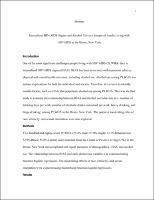Please use this identifier to cite or link to this item:
https://hdl.handle.net/20.500.12202/9001| Title: | Internalized HIV/AIDS stigma and alcohol use in a sample of adults living with HIV/AIDS in the Bronx |
| Authors: | Weinberger, Andrea H. Moadel-Robblee, Alyson Swencionis, Charles Hirky, Anne E. Shuter, Jonathan Gittleman, Jennifer |
| Keywords: | Clinical psychology AIDS Alcohol HIV HIV/AIDS Internalized Stigma Stigma |
| Issue Date: | Jun-2022 |
| Publisher: | Yeshiva University |
| Citation: | Gittleman, J. (2022, June). Internalized HIV/AIDS stigma and alcohol use in a sample of adults living with HIV/AIDS in the Bronx (Publication No. 30487174) [Doctoral dissertation, Yeshiva University]. PQDT |
| Abstract: | Introduction One of the most significant challenges people living with HIV/AIDS (PLWHA) face is internalized HIV/AIDS stigma (IHAS). IHAS has been associated with numerous adverse physical and mental health outcomes, including alcohol use. Alcohol use among PLWHA has serious implications for both the individual and society. Therefore, it is crucial to identify notable factors, such as IHAS, that perpetuate alcohol use among PLWHA. This was the first study to examine the relationship between IHAS and alcohol use behaviors (i.e., number of drinking days per week, number of alcoholic drinks consumed per week, heavy drinking, and binge drinking) among PLWHA in the Bronx, New York. The potential moderating roles of race, ethnicity, and sexual orientation were also explored. ¶ Methods Two hundred and eighty-seven PLWHA (55.4% male; 57.0% single; 72.1% heterosexual; 52.9% Black; 55.0% Latinx) were recruited from the Center of Positive Living (CPL) in the Bronx, New York and completed self-report measures of demographics, IHAS, and alcohol use. The relationship between IHAS and each alcohol use variable was examined using binomial logistic regressions. The moderating effects of race, ethnicity, and sexual orientation were explored using hierarchical binomial logistic regressions. ¶ Results The current study did not find significant associations among IHAS and alcohol use behaviors. However, race marginally moderated the effect of IHAS on the number of alcoholic drinks consumed per week, such that greater levels of IHAS were marginally protective against greater drinks consumed per week for White/Other participants (p = .066). Additionally, ethnicity moderated the effect of IHAS on the number of alcoholic drinks consumed per week, such that greater levels of IHAS were associated with fewer drinks consumed per week for Latinx participants (p = .045). It was also found that PLWHA who have lower education, lower BMI, are female, and identify their sexual orientation as bisexual/other engaged in greater drinking behaviors than PLWHA who have higher education, higher BMI, are male, and identify their sexual orientation as heterosexual or homosexual. ¶ Conclusions While IHAS was not associated with alcohol use status or alcohol use behaviors, other factors (e.g., ethnicity) were shown to be significant within this relationship. Given the high rates of alcohol use among PLWHA, further research is needed to identify factors that contribute to alcohol use in this population. Lower education, BMI, female gender, and bisexual/other sexual orientation identification are important factors to consider when screening for and implementing alcohol reduction or cessation interventions among PLWHA. |
| Description: | Doctoral dissertation, PhD / Open Access |
| URI: | https://hdl.handle.net/20.500.12202/9001 https://ezproxy.yu.edu/login?url=https://www.proquest.com/dissertations-theses/internalized-hiv-aids-stigma-alcohol-use-sample/docview/2835330688/se-2?accountid=15178 |
| ISBN: | 9798379775476 |
| Appears in Collections: | Ferkauf Graduate School of Psychology: Doctoral Dissertations |
Files in This Item:
| File | Description | Size | Format | |
|---|---|---|---|---|
| Jennifer Gittleman Dissertation June 2022 OA.pdf | 1.3 MB | Adobe PDF |  View/Open |
This item is licensed under a Creative Commons License

